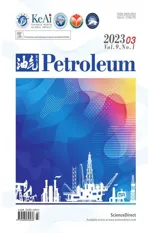Super gas wet and gas wet rock surface: State of the art evaluation through contact angle analysis
2023-08-30MohmmdAzdiTrAolfzlDehghnMonfredFlorShyeghFrzdBrzegrMohmmdHosseinGhznfri
Mohmmd Azdi Tr ,Aolfzl Dehghn Monfred ,Flor Shyegh ,Frzd Brzegr ,Mohmmd Hossein Ghznfri
a Department of Chemical and Petroleum Engineering,Sharif University of Technology,Tehran,11155-9564,Iran
b Department of Petroleum Engineering,Faculty of Petroleum,Gas and Petrochemical Engineering,Persian Gulf University,Bushehr,75169-13817,Iran
c Research Institute of Petroleum Industry,Tehran,14665-137,Iran
Keywords:Contact angle hysteresis Size-dependent behavior Surface free energy Stick-slip Wettability alteration Condensate reservoirs
ABSTRACTS Recently,super gas wet and gas wet surfaces have been extensively attended in petroleum industry,as supported by the increasing number of publications in the last decade related to wettability alteration in gas condensate reservoirs.In many cases,contact angle measurement has been employed to assess the wettability alteration.Even though contact angle measurement seems to be a straightforward approach,there exist many misuses of this technique and consequently misinterpretation of the corresponding results.In this regard,a critical inspection of the most recent updated concepts and the intervening parameters in the contact angle based wettability evaluation of liquid-solid-gas systems could aid to provide some remediation to alleviate this problem.To this end,this work presents a survey on the accurate terms and rigorous protocols based on the community of surface science and chemistry.As a preliminary step,advancing,receding,static,and the most stable contact angle terminology are defined.The study is followed by the definition of the contact angle hysteresis effect.The application of surface free energy in the selection of the best gas wet agent is then analyzed.Afterward,the impact of the sizedependent behavior of drop on contact angle is discussed.Finally,a sessile drop experiment is explained to achieve the defined parameters.For future contributions to petroleum industry journals,like this journal,this work could offer an easy use of the conceptual framework for analyzing the results and comparative evaluations in chemical wettability modifier agents.
1.Introduction
In petroleum industry,researchers use contact angle for wettability alteration evaluation such as crossovering from a wetting condition to oil wetting [1,2],water wetting [3,4],and gas wetting[5-7].Regardless of conceptual simplicity and prevalent of usage,wettability alteration measurement via change of contact angle still suffers from a lack of theoretical and experimental protocols [6-11].Many published studies in the field of wettability alteration of reservoir rock with the help of contact angle are not well defined and analyzed.This misinterpretation could be attributed to apparent simple measurement and incomplete understanding of surface wettability.Another complicating factor is the source of the contact angle concept that is in the area of surface chemistry.Obviously,with a delay,petroleum engineers will adopt the updated terminology of wettability alteration and its examination through the contact angle measurement.In the meantime,it could result in many wrong evaluations of wettability alteration.
The value of the contact angle is intensely sensitive to diverse factors.For instance,roughness[12],drop size[13],contamination[8],and surface geometry [14] could affect the measured contact angle.This sensitivity is useful in analyzing the small-scale defects of surfaces.Nevertheless,it could impose some degree of error in finding proper chemicals and optimizing the chemical structure due to the mentioned effects on wettability alteration evaluation.
In petroleum industry,wettability alteration that is experimentally measured through static contact angle is not certainly a unique value because the measured angles are not reproducible[10].It is better to consider a few other parameters.Hence,measuring this thermodynamic property,i.e.contact angle,before and after surface treatment in a static mode to determine wettability alteration is a gullible viewpoint.Neglecting this basic fact,many studies have added to the misconceptions associated with the wettability alteration measurement.This could cause a challenge in comparing the ability of different wettability modifiers,particularly for gas condensate reservoirs.
In a gas condensate producing well,a pressure reduction profile is supposed from an external boundary up to the well radii,considering this fact that a significant pressure gradient exists in the near-wellbore region.Usually,the pressure around the well falls below the reservoir fluid dew point,and hence small liquid drops begin to form on the surface of pore spaces.In this regard,at the initial states,the heavier hydrocarbon components,e.g.n-decane,would condense from the gas stream.Theoretically,the first formed liquids could appear in nanometer-sized droplets.They then enlarge through the coalesce phenomenon or further condensation.As the condensation continues,the lighter components of the reservoir fluids contributed to the liquid drop out process,results in changing the surface tension [15].Finally,a ring of condensate forms around the well that could lead to some degree of blockage and gas production decline.Wettability alteration toward gas wetting was introduced as a practical approach to alleviating the condensate banking phenomena in a gas condensate well.The change in wettability of reservoir rock to gas wet state alters the relative permeability and phase mobilization/trapping of fluids in a favorable manner such that the formed blocking condensate could be produced from the pore spaces more efficiently.Therefore,the relative permeability with respect to the gas phase is improved,and hence the gas mobility and production increases.
Regarding the above-mentioned discussions,close inspection and understanding of the different parameters that affect the liquid drop movement on a rock surface could prepare a basic framework to compare the effectiveness of different chemicals for wettability alteration purposes.To help petroleum engineers who are interest and propose some solutions for the previously discussed critical problems encountered in this area,this work tries to provide the most recent updated concepts and parameters for the wettability alteration evaluation through the contact angle measurements of sessile drop for liquid-solid-gas systems.To do this,different important parameters affecting the movement of condensate liquid are analyzed.At first,appropriate contact angle measurement for wettability alteration is discussed.The importance of hysteresis on gas wetting and liquid movement is then investigated.Afterward,the effect of reduction of surface free energy on the gas wetting phenomena is analyzed.Next,the size-dependent behavior of drop contact angle is discussed.Thereafter,the stick-slip behavior of advancing and receding drops is compared.Finally,the accurate measurement method of the mentioned parameters through the dynamic contact angle evaluation is presented.In Table 1,utilization of different parameters from conducted contact angle experiment in various studies are summarized.The absence of stick-slip parameter in the table is that it has not yet been used for wettability alteration analysis.
2.Contact angle
Young equation,which is usually used for contact angle and subsequently wetting analysis,is applicable only on an ideal surface[25].An ideal surface is a chemically homogeneous,smooth,and rigid surface without any chemical interaction with the probe liquid[13].
For wetting analysis in petroleum industry,usually,a core plug is used or sliced into several substrates.Due to the core nature,its surface is rough,porous,and chemically heterogeneous.Substrates provided from the pure minerals with zero porosity and permeability are alternates.For reducing surface roughness,surface polishing is a supposed procedure[26].However,it cannot produce an ideal surface.Moreover,in gas wetting and super gas wetting studies,the utilized chemicals and nanofluids enhance the liquid repellency through changing chemical and physical features of the surfaces[27].Physical changes are provided through forming small cavities on the surface where drop could not penetrate it.These cavities result in the formation of small air pockets under the drop with the effect of increasing contact angle [7].For this drop,different apparent contact angles based on the employed technique could be achieved (see Fig.1).This contact angle,which may represent metastable or stable equilibrium states of the system,is an average contact angle for the entire liquid-gas-solid contact line.

Table 1 Summarizing analysis technique of wettability alteration measurement from liquid wet to gas wet.

Fig.1.The Gibbs energy for a liquid drop on a typical rock surface (adapted from).
A gas wet surface has an angle higher than 90°.Based on a general rule of thumb,when a drop on a surface forms a contact angle higher than 150°,the surface is supposed to be super gas wet.Usually,the static contact angle is used for the quantitative evaluation of the wetting states.However,the static contact angle,measured when a liquid drop land on the solid surface,could lead to misleading and meaningless experimental outputs[11].Because of the randomness of drop landing,the drop could form a contact angle within the range of advancing and receding.Hence,the static contact angle is not appropriate for some wetting analysis.In some other studies,the advancing contact angle is used as a parameter for analyzing the gas wetting and super gas wetting phenomena.In this way,the highest metastable apparent contact angle resulted from increasing drop volume is advancing contact angle.Surfaces with just static or advancing contact angle higher than 150°cannot be assumed as super gas wet.Strong adhesion of drop on the surface could happen even at very high values of liquid contact angle.This behavior could be called para-liquid repellency[9].The prefix‘‘para-’’means beyond to refer to cases for which higher angles are attained due to roughness,beyond the influence of the surface chemistry.Up to now,the highest contact angle of water drop observed on smooth surfaces is 120°[28].On para-liquid repellent surfaces,a sticky drop with a high contact angle and low contact area but without any movement is observed [29].An example of such surfaces is the rose petals[30].This problem could be resolved through the reduction of the difference of receding contact angle(the lowest metastable contact angle) and the corresponding advancing contact angle.This matter is more elaborated in the next section.
Li and Firoozabadi [16] were the pioneers who experimentally confirmed the possibility of wettability alteration of different reservoir rocks(Berea sandstone core and Chalk core)from strongly liquid wetting to gas wetting condition.They utilized two fluoropolymer of FC754 and FC722 for changing the surface wettability.Their surface evaluation was performed by static contact angle measurement before and after core treatment.To do this,they placed drops of water andn-decane on the core surfaces.Fahes and Firoozabadi[19]employed FC-759 as a gas wetting agent.similarly,they conducted the static contact angle on sandstone samples by using water andn-decane.Noh and Firoozabadi [31] used fluorinated silane (L-18941) to study the wettability modification.The same as previous works,they had also utilized the static contact angle experiment for the evaluation of the wetting state.Following this procedure,Adibhatla et al.[32],Wu and Firoozabadi [18],Li et al.[17],Sharifzadeh et al.[27],Mousavi et al.[33],Karandish et al.[20],Gahrooei and Ghazanfari [34],Franco-Aguirre [35],Hoseinpour et al.[36],Jin et al.[37],Nowrouzi et al.[38],Shayesteh et al.[5] measured static contact angle for liquid-rock-gas and liquidtreated rock-gas system.The liquid phases were water and/orndecane.Hence,it can be concluded that many studies neglect the effect of other parameters in analyzing the wettability alteration of rock surfaces.Tabulated data of the literature can be found elsewhere[7,39].
2.1.Hysteresis
Hysteresis in contact angle is defined by the discrepancy of receding and advancing contact angles[40,41].It is often used as a rough symptom of the force of adhesion onto a solid(rock)surface.Some sources of contact angle hysteresis are surface roughness[42],surface deformation[43],chemical heterogeneities[44],liquid adsorption/desorption [45],and molecular rearrangement [45].Super gas wet surfaces have low drag force,low rolling angle,and low contact angle hysteresis.All these three parameters have a direct relationship with each other.As another rule,a surface is regarded as super gas wet,if the contact angle hysteresis falls between values of 0°and 5°.
Aminnaji et al.[46] used the Wilhelmy method for measurement of contact angle hysteresis on the sandstone and carbonate rock samples treated with Surfapore M.They reported advancing and receding contact angle of 140°and 110°,107°and 90°,142°and 115°,and 106°and 43°,for water-treated carbonate-air,n-Decanetreated carbonate-air system,water-treated sandstone-air,andn-Decane-treated sandstone-air system,respectively.They also observed static contact angle of 139°,95°,138°,and 104°for watertreated carbonate-air,n-Decane-treated carbonate-air system,water-treated sandstone-air,andn-Decane-treated sandstone-air system,respectively.Esmaeilzadeh et al.[21] reported contact angle hysteresis for treated carbonate rock plates with some synthesis fluorinated nanofluids.They observed a low contact angle hysteresis (<5°) and contact angle higher than 160°for a water drop.Forn-Decane,they reported a contact angle higher than 145°with the hysteresis lower than 10°.Azadi Tabar et al.[7] analyzed the hysteresis behavior of treated calcite samples with Surfapore M(a fluorinated nanofluid).They reported a sticky water drop (zero receding contact angle) while advancing and static contact angles were higher than 100°.For oil drop,they also observed no receding contact angle while the advancing and static angle was higher than 45°.
The sessile drop method is a direct technique for contact angle measurement in comparison with the Wilhelmy method.In case of accurate determination of the wetted perimeter,the Wilhelmy method is very accurate.However,on rough,porous,and textured surfaces,using the geometric perimeter results in a high error[47].As a case,in the nanostructured rough surfaces if drop partially(Cassie-Baxter state) or fully (Wenzel state) wets troughs,the geometric perimeter is much far different than true contact perimeter[47].As the focus of this work is not a comparison of the mentioned methods of contact angle,for more information related to Wilhelmy's deficiencies see [47,48].
2.2.Surface free energy
In a gas condensate reservoir,when pressure declines below its dew point,initially heavier components of the fluid condense[49].After a while,at lower pressure,lighter components condense.Generally,surface tension is directly related to the molecular weight of fluids.Also,wettability is inversely related to surface tension.It can be concluded that during the life of a gas condensate reservoir,wettability could change by variation of surface tension.Moreover,different condensate reservoirs have different fluid properties and,consequently the different surface tension.This properties variation affects the wettability.This issue was somehow investigated by for the first time [15].They synthesized different gas condensate fluids.They changed hydrocarbon composition to achieve a wide range of interfacial tension.For analyzing the effect of interfacial tension on wetting properties,they conducted static contact angle experiments on fresh and nano-treated carbonate rock samples in the presence of gas phase.They also repeated their experiments at different temperatures and pressures.They found that,at the same interfacial tension,lighter fluids are more inclined to wet surface.Surface free energy is a theory,which can be employed to relate the variation of surface tension to contact angle and wettability.Possession of lower surface free energy for a surface means being more liquid-repellent than those surfaces with higher surface free energy.The most common approaches for calculation of this energy are Zisman plot,Neumann equation,harmonic,geometric,acid-base,and Chibowski.Details of these approaches can be found elsewhere [6,50,51].Aminnaji et al.[46]performed their experiments on fresh and treated carbonate and sandstone samples to estimate surface free energy using the Chibowski equation.Their working liquids were water andn-Decane.As the Chibowski method needs advancing and receding contact angle,they used the Wilhelmy technique.Using the equation of state method,Feng et al.[24] analyzed the surface free energy reduction due to chemical treatment.They used four different liquid phase of oilfield swage,water,crude oil,and Hexadecane.Jin et al.[23] measured static contact angle of brine and Decane on fresh and treated sandstone cores for calculation of surface free energy.They estimated the surface free energy with the help of the geometric approach.Moreover,they investigated the changes of surface free energy due to different nanofluid concentration.In another study [52],they did similar examination on sandstone samples with drops of brine and Hexadecane.Azadi Tabar et al.[6]combined advancing,receding,and static contact angles of fresh and treated calcite surfaces with six methods of surface free energy estimation to calculate different liquid intermolecular forces.Even though this section has received more attention from researchers in comparison with contact angle hysteresis,it has not been precisely analyzed.The most advanced method of surface free energy,which gives a complete analysis of surface free energy,is the acid-base approach.For implementing this method,at least three different fluids with known properties are needed.However,less attention has been paid to the acid-base method.
2.3.Size-dependent behavior
The size-dependent behavior of drop on a solid surface is usually related to line tension.The line tension is the acting force on threephase contact line that precludes the contact line inward or outward movement.The size-dependent based alteration of Young's equation for a homogeneous,horizontal,smooth surface,and a symmetric drop is [53,54],
where θ,θ∞,σSLV,R,and γLVare size-dependent contact angle(ideal contact angle),the contact angle at infinite drop radius,line tension,drop radius,and surface tension,respectively.There is no agreement about the effect of line tension on the millimeter-scale of the drop.Theoretical values of line tension force are in the order of 10-9.However,on rough surfaces,the size-dependent behavior,particularly in liquid-solid-gas systems,is so important.Neglecting this effect could cause an error as high as 22°[7].Saini and Rao [55] were the first who introduced the application of the size-dependent behavior of drop for petroleum engineering.Azadi Tabar et al.[7]showed its importance in wettability alteration evaluation.In another study [56],they modeled the size-dependent-behavior of dynamic sessile drop for liquid-solid-gas system.Generally,the size-dependent behavior of drop diminishes at an inverse of radius less than 0.2 mm-1[7,13].At a constant contact angle,surfaces with positive line tension are more gas wet than the same surfaces with negative or zero line tension.A positive line tension means a higher contact angle for smaller drops.A higher contact angle could ease the movement of three-phase contact line of a condensed drop.In other words,fluid mobility is increased.Fig.2 shows the size-dependent behavior of a drop on a rock surface for different line tension values.
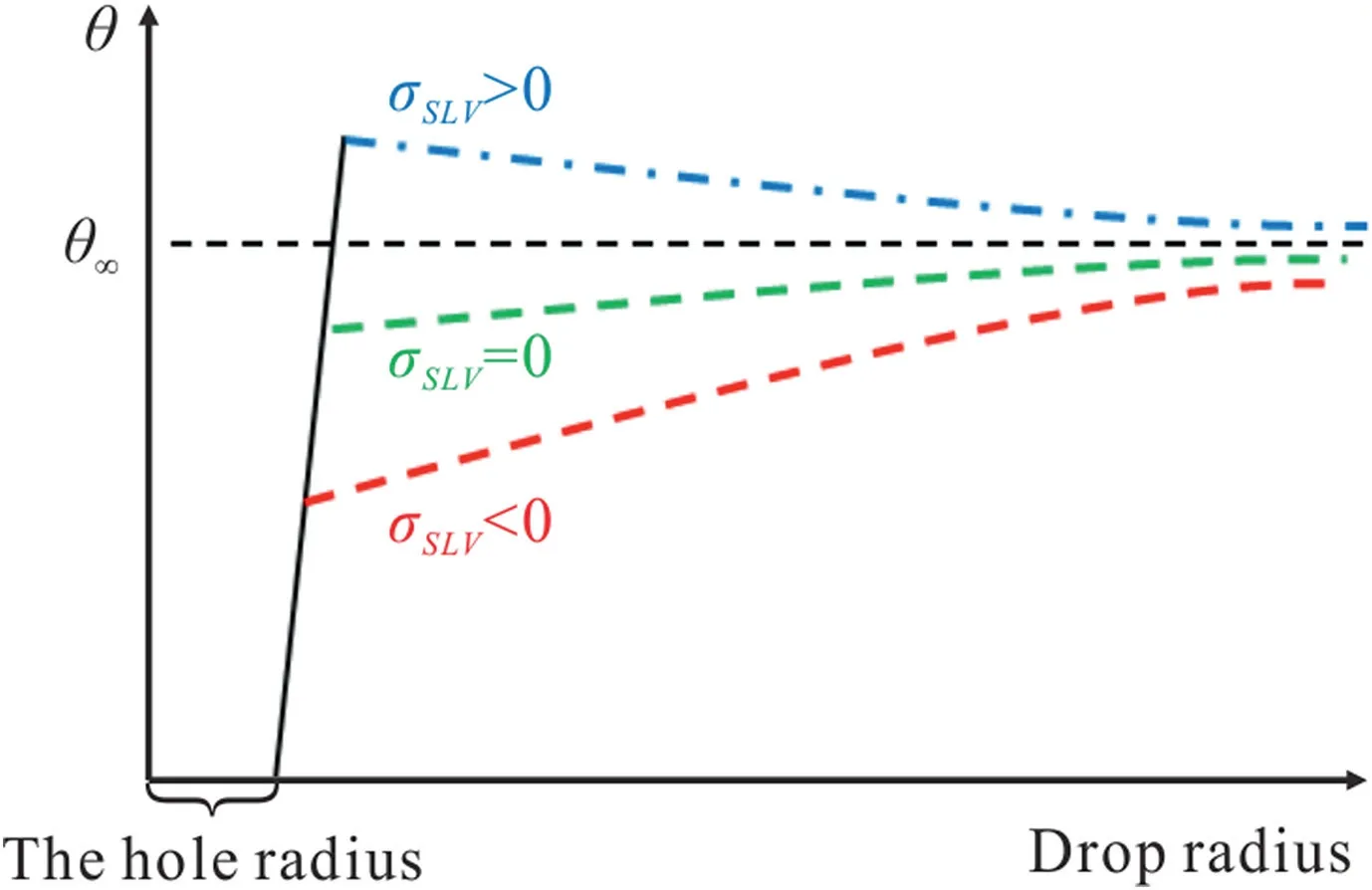
Fig.2.A typical size-dependent behavior of advancing contact angle of a drop on a rock surface in the sessile drop technique.For experimental examples see [7,13,56].
2.4.Stick-slip (pinning-depinning)
After increasing the contact angle of drop,reducing hysteresis,reducing surface free energy,and giving a minor attention to sizedependency of drop contact angle,a question might arise is that is there any other parameter(s) that might affect fluid mobility and movement or not?The answer is yes.
When a drop on rough surface advances,due to surface roughness,it encounters many barriers that might stick to them.The same behavior is applicable for a receding drop.
A stick drop results from the anchoring (pinning) force of the defect.When drop volume is increasing or decreasing,the pinning force impedes the contact line movement until the unbalanced Young force overcomes the pinning force.Depinning force (fDE,a),the threshold value of the driving force to overcome the pinning barrier,for an advancing drop is [57],
where γLvis surface tension.θa,minand θa,maxare the minimum and maximum contact angle in advanced contact angle experiment.For a receding drop,the depinning force(fDE,r) is [58],
where θrand θEare the apparent receding drop contact angle and the initial quasi-equilibrium angle.
Stick-slip behavior of an advancing contact angle of drop on a patterned surface is a kind of regular oscillation [59].Fig.3 is an example for a patterned surface.While for irregular rough surfaces,it falls between two maximum and minimum values [57] (see Fig.4).The magnitude of contact angle oscillation increases when surface roughness increases [13,59].For a receding drop on a patterned surface due to volume reduction (evaporation or suction),the change in contact angle,known as jump,increases[60](see Fig.5).The magnitude of the jump is attributed to ratio of the stripe width to the droplet size.This ratio increases by volume reduction.
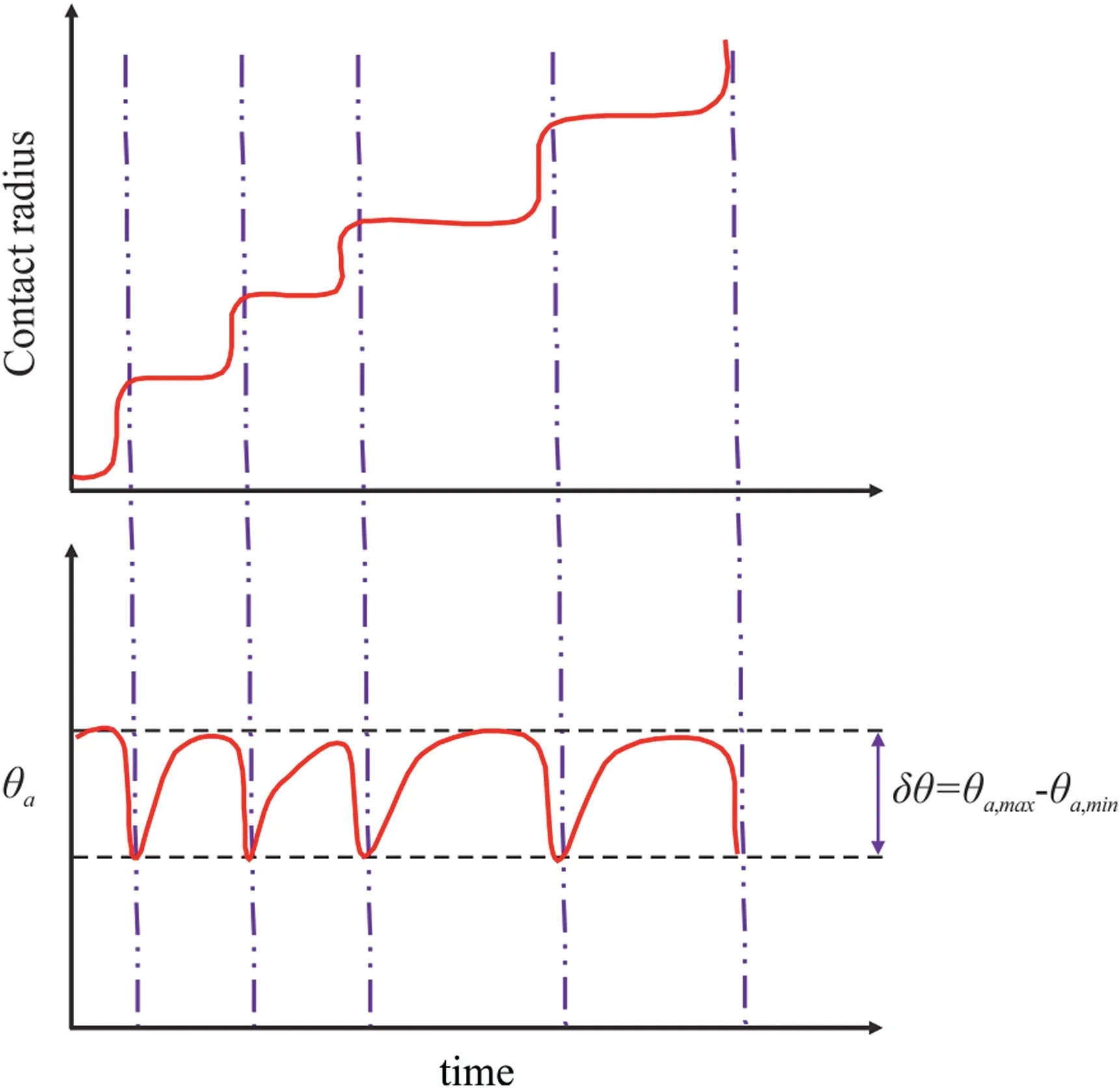
Fig.3.Typical stick-slip behavior of an advancing drop on a patterned surface.Vertical lines show end of each slip.Between two vertical lines,initially,a stick and then a slip happens.For experimental examples see [59,61].
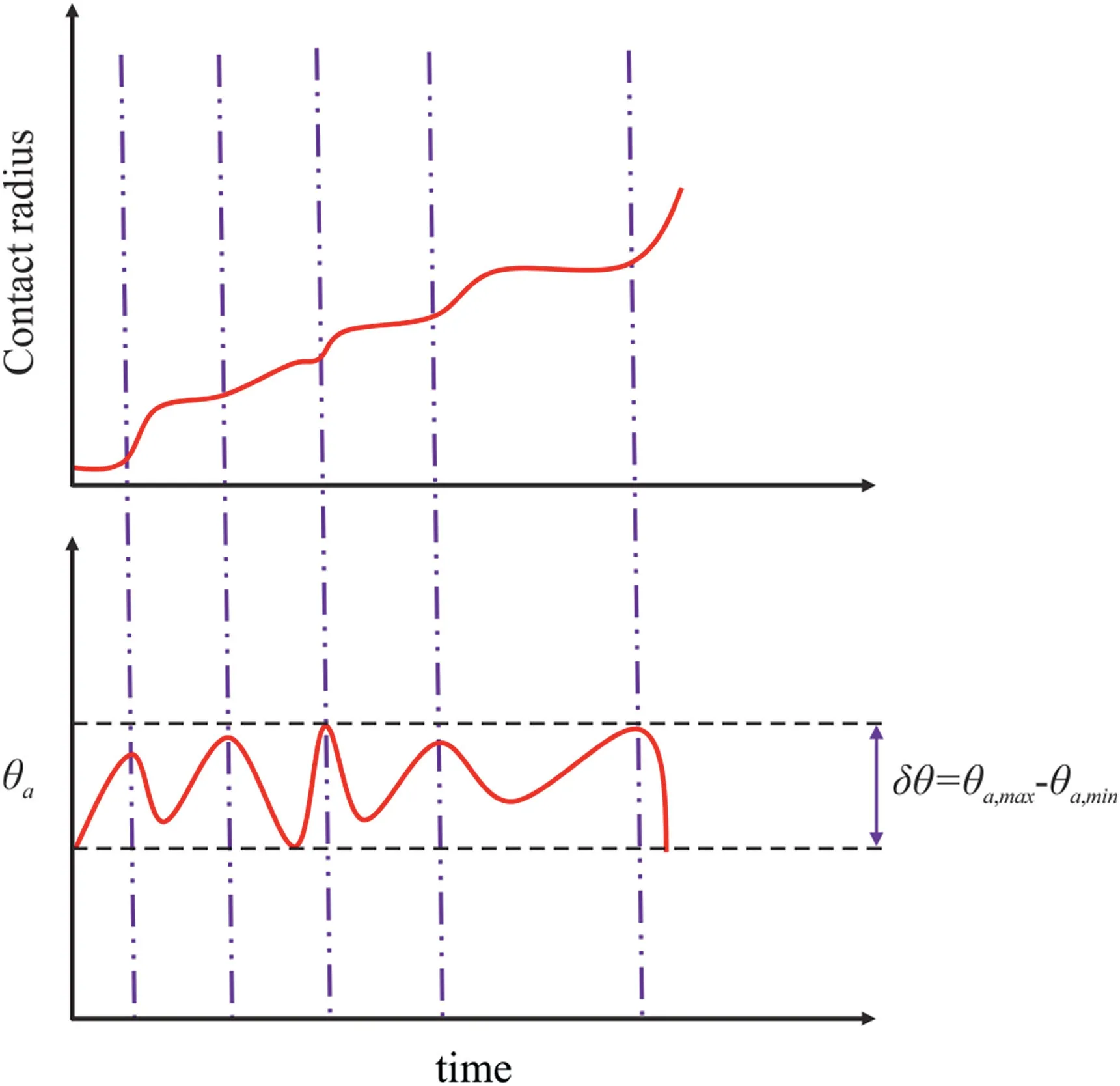
Fig.4.Typical stick-slip behavior of an advancing drop on a rock surface.Vertical lines show end of each stick.Between two vertical lines,initially,a slip and then a stick happen.For experimental examples see [57].

Fig.5.Typical stick-slip behavior of a receding drop on a rock surface.P,DP,and J are abbreviations of pining,depinning,and jump.For experimental examples see [58,60].
3.Sessile drop experiment
For achieving the mentioned parameters,a single cycle advancing and receding sessile drop experiment is adequate.The dynamic sessile drop contact angle in liquid-solid-gas systems can be performed in three different ways.In the first way,the injection can be done from below of plate(see Fig.6(a)).For this method,the middle of the plate is usually drilled.In this method,for drop volume in the range of hole size,results are affected by the drilled hole.In the second method,injection is done from upward in which the needle is above the drop but attached to it (see Fig.6(b)).As the analysis of drop profile in modern systems relies on shape profiling,it is better to detach the needle from the drop in the second method.This could enhance the accuracy of measurements [10].The third method is like the second method,but the needle has a small distance from the drop (see Fig.6(c)).
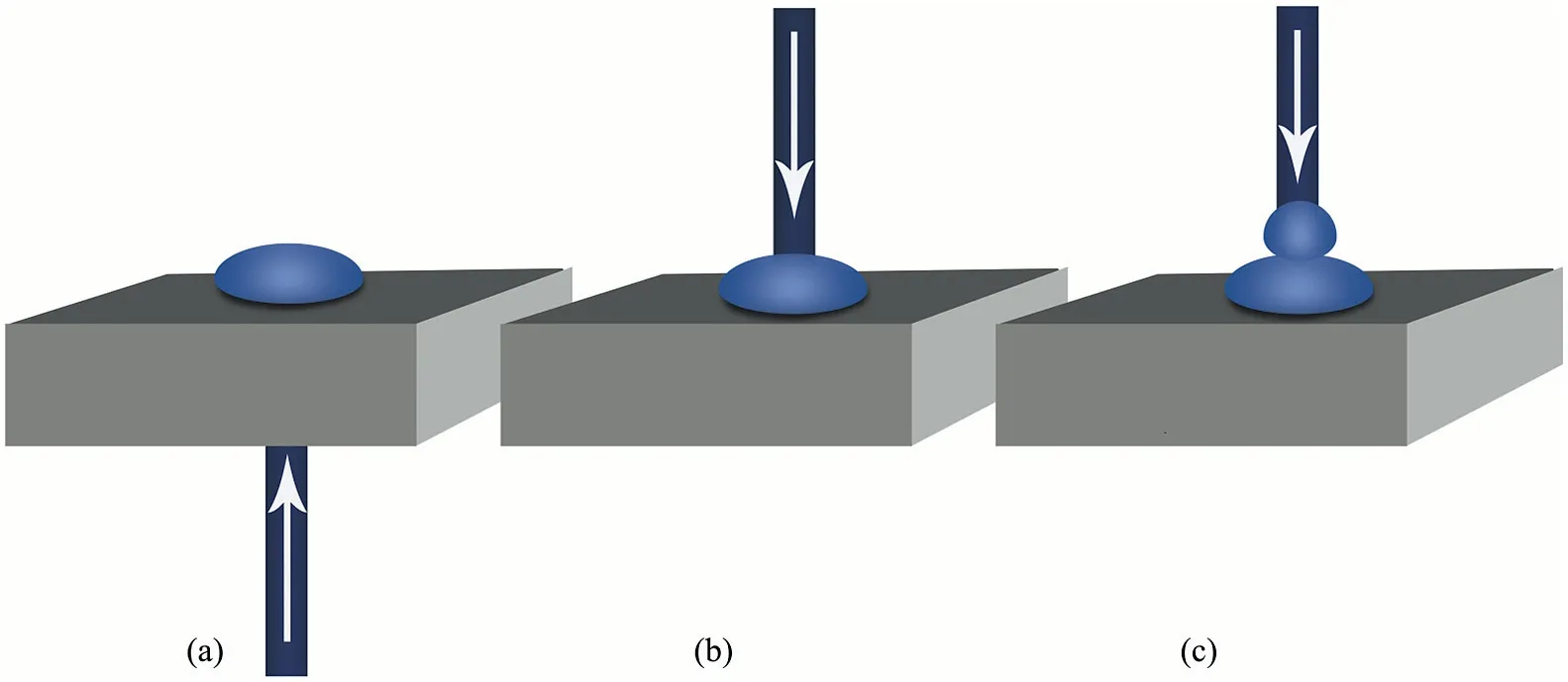
Fig.6.Sessile drop technique for measurement of contact angle.(a) Surface is drilled,and the needle is below the drop,(b) needle is within the drop,(c) needle above the drop.
The presence of the needle within the drop affects this method until drop volume becomes larger than the size of the needle or drilled hole.By increasing drop volume (radius of 2-4 mm),drop shows a size-dependent behavior.After that,advancing contact angle and stick-slip behavior of advancing drop (radius 4-6 mm)can be observed.Then,pump mode can be changed to retract the injected drop.During retraction(radius 6-4 mm),receding contact angle and stick-slip behavior can be achieved.Fig.7 depicts the advancing and receding experiments.By repeating this procedure on different samples (or different positions on one sample) for different liquids,wettability alteration and surface free energy can be achieved.

Fig.7.Schematic of advancing and receding drop measurement via the sessile drop technique.(a) injection of liquid,(b) advancing contact angle measurement,(c) retraction of liquid,(d) receding contact angle measurement.
Fig.8 shows different contact angle behaviors in an advancing contact angle test followed by a receding test.For this test,usually,on a rock surface,route of 01290 is observed(see Fig.8).Part012 of the route is the advancing section and part290 is the receding section.This route shows a high value of contact angle hysteresis(almost no receding).By reducing surface hysteresis,the other routes could be observed.Routs of 01210,012340,and012560 are different in the amount of contact angle hysteresis.The first one,which has equal advancing and receding contact angles,is theoretical and defines a rock surface with zero hysteresis.Until yet,there is not any surface with zero contact angle hysteresis.The second route has higher hysteresis than the third route.Hysteresis could be decreased by reducing chemical and physical heterogeneities.
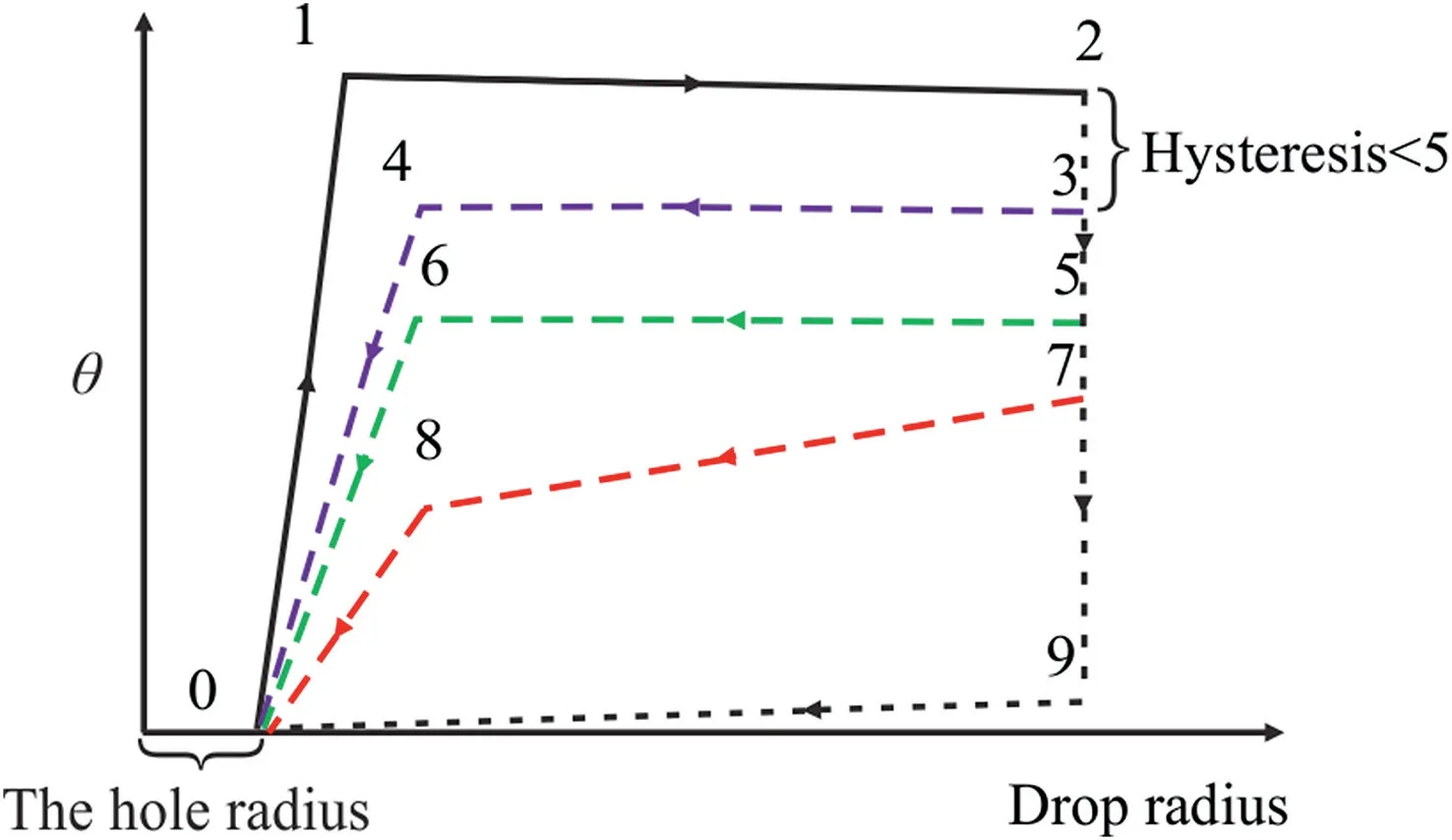
Fig.8.Schematic of typical advancing and receding behavior of sessile drop experiment.For experimental examples see [7,56,62-64].
4.Concluding remarks
It has been shown that static contact angle,most employed parameter in wettability alteration analysis,has many theoretical and experimental deficiencies.Even though Young's contact angle cannot be experimentally determined for wettability alteration analysis,advancing and receding contact angles could shed some light.Hysteresis is a necessary parameter for discriminating a super-gas wet surface.A surface is regarded as super gas wet,if the contact angle is higher than 150°and hysteresis falls between values of 0°and 5°.Surface free energy is the most critical parameter for evaluation of the liquid repellency strength of different fluids.Two other parameters,that affect wettability alteration analysis,but received less attention are line tension and stick-slip behavior.This work will benefit many scientists to avoid past mistakes in evaluating surface wettability with the help of contact angle measurements.It could also eliminate misinterpretations of results of contact angle measurement.
Declaration of competing interest
The authors declare that they have no known competing financial interests or personal relationships that could have appeared to influence the work reported in this paper.
杂志排行
Petroleum的其它文章
- Petroleum system analysis-conjoined 3D-static reservoir modeling in a 3-way and 4-way dip closure setting: Insights into petroleum geology of fluvio-marine deposits at BED-2 Field (Western Desert,Egypt)
- Development and performance evaluation of a high temperature resistant,internal rigid,and external flexible plugging agent for waterbased drilling fluids
- Anti-drilling ability of Ziliujing conglomerate formation in Western Sichuan Basin of China
- Production optimization under waterflooding with long short-term memory and metaheuristic algorithm
- Investigation of replacing tracer flooding analysis by capacitance resistance model to estimate interwell connectivity
- Experimental study on sand production and coupling response of silty hydrate reservoir with different contents of fine clay during depressurization
